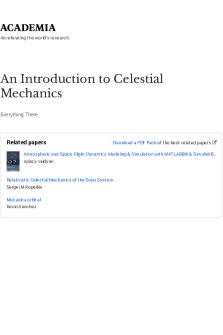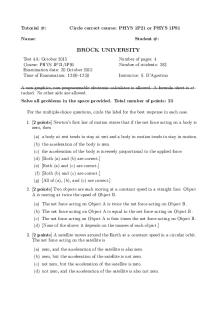1 Introduction to Engineering Mechanics PDF

| Title | 1 Introduction to Engineering Mechanics |
|---|---|
| Author | eliie santos |
| Course | Statics Of Rigid Bodies |
| Institution | Technological Institute of the Philippines |
| Pages | 11 |
| File Size | 652.2 KB |
| File Type | |
| Total Downloads | 16 |
| Total Views | 165 |
Summary
Introduction to Engineering Mechanics...
Description
#1
CESTAT30 – STATICS OF RIGID BODIES FLEX Course Material
Identify the principles of Engineering Mechanics Enumerate axioms of Mechanics. Recite Newton’s Laws of motion.
Identify different kinds of force systems.
INTRODUCTION TO ENGINEERING MECHANICS Marvin M. Bartido, RCE
1ST TERM AY 2020-2021
PRE-ASSESSMENT
Pr Pre-a e-a e-asses sses ssessm sm smen en entt No No.. 1 CONVERSION OF UNITS
Convert the following: 1. 10 m to km 2. 25 inches to feet 3. 50 kg to lb 4. 5’ 7” to cm 5. 60 km/hr to mi/sec 6. 25 𝑚2 to 𝑓𝑡 2
Table of Contents Introduction to Engineering Mechanics: Definition of Terms Engineering Mechanics Engineering Mechanics Branches of Engineering Mechanics Statics Dynamics Rigid Body Force Force System Newton’s Law of Motion Axioms of Mechanics Scalar and Vector Quantities Dimensional Checks Conversion of Units Problem Formulation and the Accuracy of Solutions Introduction to Resultant of Force Systems
3
I can do all things through Christ who gives me strength. Philippians 4:13
INTRODUCTION TO ENGINEERING MECHANICS – DEFINITION OF TERMS Engineering is the application of the mathematical and physical sciences (physics, chemistry, and biology) to the design and manufacture of items that benefit humanity. Mechanics is the branch of physics that considers the action of forces on bodies or fluids that are at rest or in motion. Engineering Mechanics is the branch of engineering that applies the principles of mechanics to mechanical design (i.e., any design that must take into account the effect of forces). Branches of Engineering Mechanics 1. Statics – we consider the effects and distribution of forces on rigid bodies which are and remain at rest. 2. Dynamics – we consider the motion of rigid bodies caused by the forces acting upon them. Rigid Body – defined as a definite amount of matter the parts of which are fixed in position relative to each other. Force – defined as that of which changes, or tends to change the state of motion of a body. If a force F acts on a particle of mass m, Newton’s second law states that F = ma where m is mass and a is acceleration (F = mg where g is acceleration due to gravity equal to 9.81 𝑚 𝑠2 for metric system). Unit of Force • SI (Metric) System 1.0 𝑘𝑔∙ 𝑚 2 = 1.0 N (Newton) 𝑠 • English System 𝑓𝑡 1.0 𝑠𝑙𝑢𝑔 ∙ 𝑠 2 = 1.0 lb (Pound)
4
I can do all things through Christ who gives me strength. Philippians 4:13
INTRODUCTION TO ENGINEERING MECHANICS Force System – any arrangement where two or more forces act on a body or on a group of related bodies.
(a)
(b)
(c)
(d) Different Kinds of Force Systems (a) According to plane it lies Coplanar – force system lie in one plane, otherwise they are Non-coplanar. (Figures a, b and c are coplanar. Figure d is non-coplanar) (b) According to line of action Concurrent Force System – the lines of action of forces pass through a common point. (Figure a is concurrent) Parallel Force System – lines of action of forces are parallel. (Figure c is parallel) Non-concurrent Force System – lines of action of forces are neither parallel nor intersect in a common point (Figure b is non-concurrent)
5
I can do all things through Christ who gives me strength. Philippians 4:13
INTRODUCTION TO ENGINEERING MECHANICS NEWTON’S LAW OF MOTION 1. Law of Inertia – states that a body at rest will remain at rest unless acted on by a force. 2. 3.
Law of Acceleration – states that a body acted on by a force will accelerate in the direction of the force. Law of Action and Reaction – states that in every action, there is an equal and opposite reaction.
AXIOMS OF MECHANICS 1. The parallelogram law: The resultant of two forces is the diagonal of the parallelogram formed on the vectors of these forces. 2. 3.
4.
Two forces are in equilibrium only when equal in magnitude, opposite in direction, and collinear in action. A set of forces in equilibrium may be added to any system of forces without changing the effect of the original system. Action and reaction forces are equal but oppositely directed.
SCALAR AND VECTOR QUANTITIES Scalars – quantities which possess magnitude only and can be added arithmetically. They are real numbers that can be positive, negative, or zero. Vectors – quantities which possess both magnitude and direction and can be combined geometrically. Force is an example of physical quantity that is a vector.
30N
+
100N
= 6
70N
I can do all things through Christ who gives me strength. Philippians 4:13
INTRODUCTION TO ENGINEERING MECHANICS DIMENSIONAL CHECKS 𝑣 2 =𝑣0 2 +2𝑎𝑠 2 𝑚 = 𝑚 𝑠 2 +2(𝑚 𝑠 2 𝑚 = 𝑚𝑠 2 𝑠
𝑠2
)(𝑚)
CONVERSION OF UNITS
7
I can do all things through Christ who gives me strength. Philippians 4:13
INTRODUCTION TO ENGINEERING MECHANICS Examples: Convert the following: 1. 450km to cm 2. 5 meters to inches 3. 400.35 hectogram to slug 4. 60 miles per hour to meter per second 5. 1 𝑠𝑙𝑢𝑔∙𝑓𝑡 𝑠2
to 𝑘𝑔∙ 𝑚
𝑠2
Solutions: 1. 450km to cm
10000 𝑐𝑚 = 4500000 𝑐𝑚 450 𝑘𝑚 𝑥 1 𝑘𝑚 2. 5 meters to inches 1 𝑖𝑛 100 𝑐𝑚 𝑥 = 196.85 𝑖𝑛 5𝑚𝑥 1𝑚 2.54 𝑐𝑚 3. 400.35 hectogram to slug 1 𝑘𝑔 1 𝑠𝑙𝑢𝑔 𝑥 =2.74 𝑠𝑙𝑢𝑔 400.35 𝑔 𝑥 10 𝑔 14.59 𝑘𝑔 4. 60 miles per hour to meter per second 𝑚𝑖 1.61 𝑘𝑚 1000 𝑚 1 𝑟 1 𝑚𝑖𝑛 60 =26.83 𝑚 𝑠 𝑥 𝑥 𝑥 𝑥 1 𝑘𝑚 60 𝑚𝑖𝑛 60 𝑠𝑒𝑐 1 𝑚𝑖 𝑟 𝑓𝑡 𝑚 5. 1 𝑠𝑙𝑢𝑔∙ 𝑠2 to 𝑘𝑔∙ 𝑠2 𝑓𝑡 14.59 𝑘𝑔 1𝑚 1 𝑠𝑙𝑢𝑔 ∙ 2 𝑥 =4.448 𝑘𝑔∙ 𝑚 2 𝑥 𝑠 3.28 𝑓𝑡 1 𝑠𝑙𝑢𝑔 𝑠
8
I can do all things through Christ who gives me strength. Philippians 4:13
INTRODUCTION TO ENGINEERING MECHANICS PROBLEM FORMULATION AND THE ACCURACY OF SOLUTIONS To help you develop an “engineering approach” to problem analysis, you will find it instructive to divide your solution for each homework problem into the following parts: 1. GIVEN: After carefully reading the problem statement, list all the data provided. If a figure is required, sketch it neatly and approximately to scale. 2. FIND: State precisely the information that is to be determined. 3. SOLUTION: Solve the problem, showing all the steps that you used in the analysis. Work neatly so that your work can be easily followed by others. 4. VALIDATE: Many times, an invalid solution can be uncovered by simply asking yourself, “Does the answer make sense?”
9
I can do all things through Christ who gives me strength. Philippians 4:13
INTRODUCTION TO RESULTANT OF FORCE SYSTEMS Resultant – a single force or vector that is the equivalent of a set of forces or vectors. 30N
+
100N
=
70N (Resultant)
These force systems can be represented by its resultant (red arrows).
10
ASSESSMENT TASK
Assess Assessmen men mentt Task No No.. 1 Topic Learning Outcome: Convert units Identify different kinds of force system I. Convert the following: 1. 0.5 m to cm 2. 5 meters to miles 3. 400.35 hectogram to pound 4. 60 miles per day to cm per second 5. 400 N to lb 6. 100 𝑁 𝑚 to 𝑙𝑏 𝑓𝑡
7. If 𝑃𝑎𝑠𝑐𝑎𝑙 𝑃𝑎 𝑖𝑠 𝑘𝑖𝑝𝑠 𝑓𝑡 2 .
𝑁 𝑚2
and kips is kilopounds , convert 2 MPa to
8. 173 cm to __’ __” (__ft __in) 9. If your mass is 80 kg because you ate so much during lockdown, what is your weight in Newton? 10. 9.81 𝑚
𝑠2
to 𝑓𝑡 𝑠2
II. Draw 2 examples each of the different kinds of force system according to the line of action.
11...
Similar Free PDFs

Module 1 Introduction To Mechanics
- 11 Pages

Introduction to Fluid Mechanics
- 321 Pages

Introduction to chemical engineering
- 255 Pages

Introduction to Engineering Drawing
- 16 Pages

Fay - Introduction to Fluid Mechanics-1
- 232 Pages

An Introduction to Celestial Mechanics
- 217 Pages
Popular Institutions
- Tinajero National High School - Annex
- Politeknik Caltex Riau
- Yokohama City University
- SGT University
- University of Al-Qadisiyah
- Divine Word College of Vigan
- Techniek College Rotterdam
- Universidade de Santiago
- Universiti Teknologi MARA Cawangan Johor Kampus Pasir Gudang
- Poltekkes Kemenkes Yogyakarta
- Baguio City National High School
- Colegio san marcos
- preparatoria uno
- Centro de Bachillerato Tecnológico Industrial y de Servicios No. 107
- Dalian Maritime University
- Quang Trung Secondary School
- Colegio Tecnológico en Informática
- Corporación Regional de Educación Superior
- Grupo CEDVA
- Dar Al Uloom University
- Centro de Estudios Preuniversitarios de la Universidad Nacional de Ingeniería
- 上智大学
- Aakash International School, Nuna Majara
- San Felipe Neri Catholic School
- Kang Chiao International School - New Taipei City
- Misamis Occidental National High School
- Institución Educativa Escuela Normal Juan Ladrilleros
- Kolehiyo ng Pantukan
- Batanes State College
- Instituto Continental
- Sekolah Menengah Kejuruan Kesehatan Kaltara (Tarakan)
- Colegio de La Inmaculada Concepcion - Cebu









